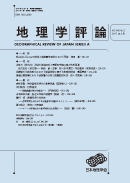Volume 84, Issue 2
Displaying 1-13 of 13 articles from this issue
- |<
- <
- 1
- >
- >|
REVIEW ARTICLE
-
Article type: REVIEW ARTICLE
2011Volume 84Issue 2 Pages 99-117
Published: March 01, 2011
Released on J-STAGE: September 28, 2015
Download PDF (525K)
RESEARCH NOTES
-
Article type: RESEARCH NOTE
2011Volume 84Issue 2 Pages 118-130
Published: March 01, 2011
Released on J-STAGE: September 28, 2015
Download PDF (2897K) -
Article type: RESEARCH NOTE
2011Volume 84Issue 2 Pages 131-144
Published: March 01, 2011
Released on J-STAGE: September 28, 2015
Download PDF (1560K) -
Article type: RESEARCH NOTE
2011Volume 84Issue 2 Pages 145-159
Published: March 01, 2011
Released on J-STAGE: September 28, 2015
Download PDF (4044K)
BOOK REVIEWS
-
Article type: BOOK REVIEW
2011Volume 84Issue 2 Pages 160-161
Published: March 01, 2011
Released on J-STAGE: September 28, 2015
Download PDF (359K) -
Article type: BOOK REVIEW
2011Volume 84Issue 2 Pages 161-162
Published: March 01, 2011
Released on J-STAGE: September 28, 2015
Download PDF (358K) -
Article type: BOOK REVIEW
2011Volume 84Issue 2 Pages 162-164
Published: March 01, 2011
Released on J-STAGE: September 28, 2015
Download PDF (363K) -
Article type: BOOK REVIEW
2011Volume 84Issue 2 Pages 164-166
Published: March 01, 2011
Released on J-STAGE: September 28, 2015
Download PDF (369K) -
Article type: BOOK REVIEW
2011Volume 84Issue 2 Pages 166-169
Published: March 01, 2011
Released on J-STAGE: September 28, 2015
Download PDF (370K)
MISCELLANEOUS RECORDS
-
Article type: MISCELLANEOUS RECORD
2011Volume 84Issue 2 Pages 170-193
Published: March 01, 2011
Released on J-STAGE: September 28, 2015
Download PDF (783K) -
Article type: MISCELLANEOUS RECORD
2011Volume 84Issue 2 Pages 194-195
Published: March 01, 2011
Released on J-STAGE: September 28, 2015
Download PDF (383K) -
Article type: MISCELLANEOUS RECORD
2011Volume 84Issue 2 Pages 196-198
Published: March 01, 2011
Released on J-STAGE: September 28, 2015
Download PDF (395K) -
Article type: MISCELLANEOUS RECORD
2011Volume 84Issue 2 Pages 2_cover2-cover3
Published: March 01, 2011
Released on J-STAGE: September 28, 2015
Download PDF (107K)
- |<
- <
- 1
- >
- >|
